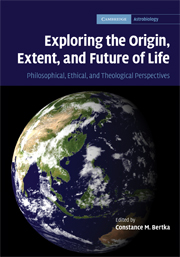 Exploring the Origin, Extent, and Future of Life
Exploring the Origin, Extent, and Future of Life Book contents
- Frontmatter
- Contents
- List of contributors
- Acknowledgements
- 1 Astrobiology in a societal context
- Part I Origin of life
- Part II Extent of life
- 7 A biologist's guide to the solar system
- 8 The quest for habitable worlds and life beyond the solar system
- 9 A historical perspective on the extent and search for life
- 10 The search for extraterrestrial life: epistemology, ethics, and worldviews
- 11 The implications of discovering extraterrestrial life: different searches, different issues
- 12 God, evolution, and astrobiology
- Part III Future of life
- Index
- References
7 - A biologist's guide to the solar system
from Part II - Extent of life
Published online by Cambridge University Press: 29 December 2010
- Frontmatter
- Contents
- List of contributors
- Acknowledgements
- 1 Astrobiology in a societal context
- Part I Origin of life
- Part II Extent of life
- 7 A biologist's guide to the solar system
- 8 The quest for habitable worlds and life beyond the solar system
- 9 A historical perspective on the extent and search for life
- 10 The search for extraterrestrial life: epistemology, ethics, and worldviews
- 11 The implications of discovering extraterrestrial life: different searches, different issues
- 12 God, evolution, and astrobiology
- Part III Future of life
- Index
- References
Summary
Introduction
Astrobiology has life at its core: Where does life come from? Where is it going? Are we alone? While it includes the search for extraterrestrial life – the very bit that has so captured the public's attention – it uses life on Earth as its reference point. Of course this probably has less to do with philosophy, and more to do with practicalities. After all, there is only one place that we know with certainty contains life, and most likely an indigenous biota at that. So, planet Earth remains the reference point. Thus, a search for life elsewhere, even in our own solar system, must include an understanding of the known range of life on Earth. And, even before that, an understanding of what we mean by “life.”
Understanding the range of current life on Earth, and mapping it to current environments in the solar system, is only a start as it lacks the element of time. Life on Earth may have been substantially different when it arose around about 4 billion years ago because the environmental range on Earth was dramatically different. Similarly, the climatic conditions forecast for a billion or so years into the future are bleak for much of life as we know it, including ourselves. Without intervention, the Sun as we know it will not even exist.
- Type
- Chapter
- Information
- Exploring the Origin, Extent, and Future of LifePhilosophical, Ethical and Theological Perspectives, pp. 115 - 142Publisher: Cambridge University PressPrint publication year: 2009
References
- 1
- Cited by


